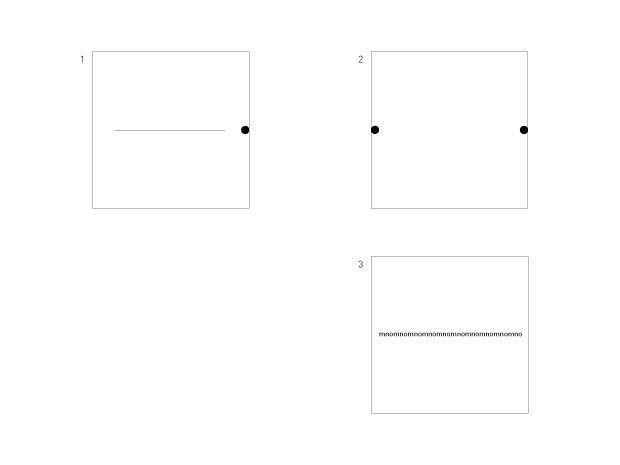 [/wide]
[/wide]
We will now place a dot at the right hand side of this horizontally restricted rule (1). The rule begins to work its way hesitantly to the right, it starts to flirt with the dot.
Between two dots (2) something comes into being which, according to the view of all rational thought, should not happen. There appears the imaginary rule, the rule as we see it, the optical rule. Between the dots the plane becomes ploughed through by a strip of tension.
In the strict sense of the word a line of type (3) is not a rule either. The resulting line is imaginary,
the individual characters produce a linear effect in the way they are set. By increasing the character spacing this effect would be considerably weaker, but it could never really be eliminated altogether.
If our modes of expression are restricted when using the typographical rule,
then the way to attractive possibilities is opened up if we place the rule in contrast to the plane.
Helmut Schmid has wonderfully restructured the article in the idea 352 based on the article to be published in the January 1958 issue of “Typografische Monatsblatter” by Emil Ruder. So, we highly recommended that to be read the idea 352 thoroughly. And then you can get a deep understanding of this article.
この、左右の限られた水平罫の右となりに、我々は ひとつの点を置いてみよう(1)。 非常にためらいながらも、この罫は右の方向へと向き、やがてこの点とたわむれ始める。
二つの点の間(2)には、あらゆる合理的思考の観点からはあるべきではないものが生じる。そこには架空の線が、我々の想像の中の線が、光学的な線が生じるのだ。二つの点の間で、平面は張り詰めた筋によって畝立てされる。
活字の行(3)は、言葉の厳密な意味においては罫ではない。この行は想像上の罫を生じ、個々の文字はその並び方によって線的な効果を生み出している。文字の間をもっと 広げていけばこうした効果は著しく弱まるだろうが、 完全に消えることはまずないだろう。
もしも我々の表現方法が、タイポグラフィの罫線だけに限定されるとしても、罫を平面と対置させることで、諸々の魅力的な可能性が開かれるのだ。
このコンテンツはTypografische Monatsblatterの1958 1月号に掲載されたEmil Ruder氏の寄稿記事をHelmut Schmid氏が40年以上の歳月を要し、idea 352の中で編集、デザイン、紹介されたものを一部引用したものです。
次のことをお勧めします、もしあなたがidea 352を熟読すると、このコンテンツを表面的なレベルより深く理解することができます。